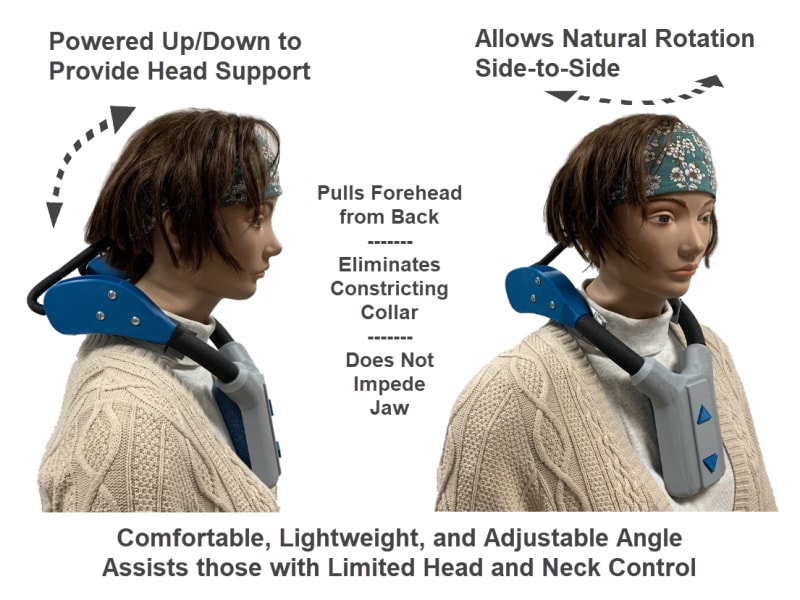To improve quality of life for people with limited head or neck control, this innovation comfortably provides head support from the forehead instead of the chin, to allow eating, talking, side-to-side and up-down motion, while eliminating jaw discomfort from traditional neck braces.
This device is not intended for situations requiring neck immobilization but could benefit many people who have various medical conditions such as chronic neck pain, Cervical Dystonia (Spasmodic Torticollis), muscle weakness, ALS (Amyotrophic Lateral Sclerosis), Cervical Spondylosis, drop head (also known as drooped head, floppy head syndrome, or head ptosis), Spinal Muscular Atrophy, Torticollis (also known as wryneck or twisted neck).
For those with long-term or permanent conditions like these, wearing a traditional neck collar regularly can be uncomfortable, limits eating, talking, turning the head side-to-side, and may make jaw conditions like TMJ (Temporomandibular Joint Dysfunction) even worse.
This novel head support helps solve these issues with a motorized, battery powered, self-contained unit using simple up/down control buttons. It can be stopped at any angle in its range for watching TV, eating, going to the bathroom, tying shoes, playing games, walking, and most other daily activities. The mechanism transfers the 10 to 12 lbs (4.5 to 5.4 kg) of head mass onto the wearer’s shoulder muscles and rib cage rather than compressing the jaw from underneath.
This device’s comfortable design spreads out the pressure on the forehead with super-cushioning polyurethane rubber and a custom self-tensioning system to allow it to be used for long periods of time. It is compatible with scarves, hats, visors, and headbands. The fabric components are washable.
Depending on the size of the head and/or the amount of muscle strength available, an optional strap down the wearer’s back and around the rib cage can be used to support the weight of the head in conjunction with the built-in neck strap and chest force-transfer mechanism.
This innovation was developed for an adult male in central Pennsylvania. As a complication of unrelated spinal surgery in the neck area, the gentleman was left unable to hold his head up. This resulted in a lower quality of life, including difficulty walking, eating, talking (compressed vocal cords), and not being able to make eye contact while having a conversation. He tried many different types of neck braces, but all the products caused severe discomfort because the entire weight of his head was resting on his jaw.
This new head support is made from commercially available parts, basic electronics, a few custom plastic components, standard metal machining and assembly, so it could be mass produced. It would be more expensive than simple foam or plastic cervical collars, but within the range of other types of assistive devices.
Like this entry?
-
About the Entrant
- Name:Eric Steffy
- Type of entry:individual
- Patent status:none


